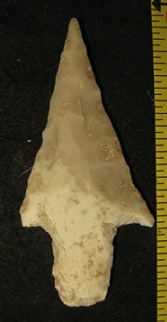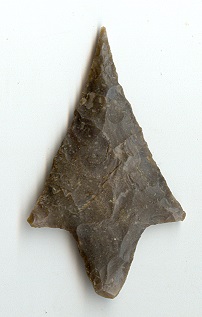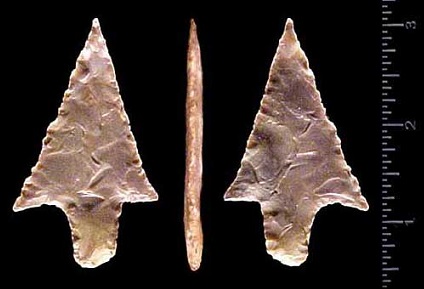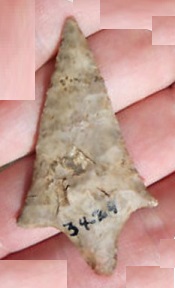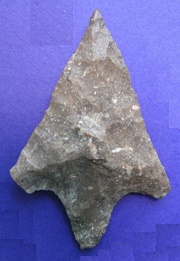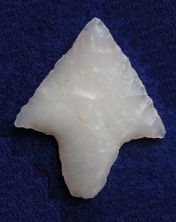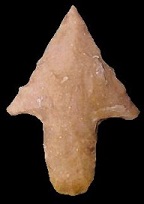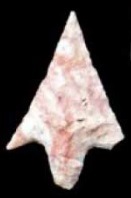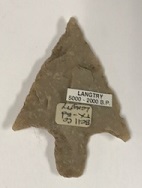Outline is Representative of Size and Shape:

Name Details:
Identified By: Leland C. Bement
Named For: Type Site
Date Identified: 1991
Type Site: Arenosa Shelter, Pecos River, Texas
Identified By: Leland C. Bement
Named For: Type Site
Date Identified: 1991
Type Site: Arenosa Shelter, Pecos River, Texas
Point Validity:
Valid type
Benent is an anthropologist and a professor for the Department of Anthropology, University of Oklahoma. He serves as the Archaeologist for the Oklahoma Archaeological Survey. This point was identified in a professional publication and has many professional references. This is considered a valid type.
Benent is an anthropologist and a professor for the Department of Anthropology, University of Oklahoma. He serves as the Archaeologist for the Oklahoma Archaeological Survey. This point was identified in a professional publication and has many professional references. This is considered a valid type.
Langtry Arenosa Contracting Stem
AKA: Arenosa Contracting StemCluster:
Description of Physical Characteristics and Flaking Pattern:
This is a thin medium triangular contracting stem point with a flattened to elliptical cross section. The blade is primarily straight, but may range from slightly excurvate to slightly incurvate. The shoulders are usually at a downward slope or angle, but may vary to horizontal. The stem is contracting with a convex to pointed base. This point is usually well made point with a random flaking pattern.
Size Measurements:
Length - 40 to 70 mm (average 60 mm), Stem Length - 12 to 20 mm (typically 1/4 to 1/2 the total length, could be a little longer for this variation), Width at shoulders - 22 to 40 mm, Stem Width - 6 to 16 mm
Length - 40 to 70 mm (average 60 mm), Stem Length - 12 to 20 mm (typically 1/4 to 1/2 the total length, could be a little longer for this variation), Width at shoulders - 22 to 40 mm, Stem Width - 6 to 16 mm
Commonly Utilized Material:
Additional Comments:
Suhm and Krieger (1954) included both the classic Langtry and the newer identified Langtry Arenosa into the Langtry type. They noted that the two may represent separate type, but the two represent a continuum and is difficult to draw a clear line between the two types.
Unlike the Langtry point, this point does not have usually have beveling on the base, but may be seen on the stem (Turner and Hester, 1985).
This is a variant of the Langtry type. The Langtry type generally has a straight to concave base and barbed shoulders. The Langtry Arenosa variant has a longer rounded stem and barbed shoulder. This variant has a long rounded stem and weak shoulders that are horizontal to having an upward angle. The characteristics of the Arenosa and Jora type overlap and both are poorly defined. The difference between the two types may be a result of reduced shoulders due to re-sharpening. However, many publications refer to this type as the Arenosa / Jora type (Bement, 1999)
Suhm and Krieger (1954) included both the classic Langtry and the newer identified Langtry Arenosa into the Langtry type. They noted that the two may represent separate type, but the two represent a continuum and is difficult to draw a clear line between the two types.
Unlike the Langtry point, this point does not have usually have beveling on the base, but may be seen on the stem (Turner and Hester, 1985).
This is a variant of the Langtry type. The Langtry type generally has a straight to concave base and barbed shoulders. The Langtry Arenosa variant has a longer rounded stem and barbed shoulder. This variant has a long rounded stem and weak shoulders that are horizontal to having an upward angle. The characteristics of the Arenosa and Jora type overlap and both are poorly defined. The difference between the two types may be a result of reduced shoulders due to re-sharpening. However, many publications refer to this type as the Arenosa / Jora type (Bement, 1999)
Distribution:

Distribution Comments:
This point is primarily found in the lower Pecos River into the Trans-Pecos region into southeastern New Mexico and northern Coahuila. Extends into the Nueces River Valley of Texas and central Tamaulipas. Frequency decreases towards the coastal regions.
This point is primarily found in the lower Pecos River into the Trans-Pecos region into southeastern New Mexico and northern Coahuila. Extends into the Nueces River Valley of Texas and central Tamaulipas. Frequency decreases towards the coastal regions.
Age / Periods:
Date: 4,500 - 3,000 B.P.
Cultural Period: Middle Archaic
Glacial Period: Neoglacial
Culture:
Date: 4,500 - 3,000 B.P.
Cultural Period: Middle Archaic
Glacial Period: Neoglacial
Culture:
Age Details:

